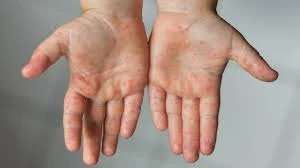Is Tomato fever as Dangerous as COVID-19. Dengue, and Chikungunya infections, are they similar?
 |
| Is tomato fever as dangerous as COVID-19? Dengue and Chikungunya infections: are they similar?. 2022 |
Overview
The tomato fever was foremost reported in the Kerala district of Kerala (India) on the 6th of May 2022, and exactly at the same time as the 26th of July 2022, more than 82 kids under 5 years of age reported this infection.
While most countries of the world were dealing with the emergence of the new wave of COVID-19, with the corresponding monkeypox pandemic, a new virus was introduced known as tomato fever or tomato flu.
This piece of writing will provide all facts about the tomato flu with the similarities of COVID-19, chikungunya, and dengue.
Is tomato fever spreading all around the world?
The uncommon viral illness is considered in an endemic state, but it is believed to be a non-life-threatening infection.
Conversely, after the terrible experience of the COVID-19 pandemic and the endemic threat of monkeypox, cautious management should be followed in order to prevent supplementary outbreaks.
Initially, it was reported from Kerala, then the other areas such as Aryankavu, Neduvadthur, Anchal, and the nearest states of Karnataka and Tamil Nadu. 26 kids aged 1-9 years furthermore have been reported in Orisha by RMRCB (Regional Medical Research Centre in Bhubaneswar).
Apart from these states (Urisha, Tamil Nadu, and Kerala), no other regions in India have been influenced so far.
Why are people puzzled about tomato fever with the Chikungunya, COVID-19, and dengue infections?
Generally, people are puzzled about the tomato flu with COVID-19, dengue, and chikungunya because some of the symptoms of these infections, such as headache, fever, fatigue, body aches, and rashes on the skin, are similar to tomato fever. Tomato flu is not connected with the viruses COVID-19 (SRS-CoV-2), dengue, and chikungunya.
Prime symptoms like high fever, painful blisters, and intense pain in joints of tomato fever are similar to Chikungunya.
Due to the eruption of red and painful blisters all over the body that progressively enlarge to the size of a tomato, that’s why tomato fever got this name.
Is Tomato Flu a life-threatening disease?
Tomato fever is a self-restricting disease, and there is no specified medicine to treat it so far.
Reasons why Tomato fever is similar to COVID-19, Dengue, and Chikungunya
The exact reason is unknown yet, but health experts considered the tomato flu infection could be the subsequent effect of chikungunya and dengue.
The health experts considered the Tomato Flu virus could be a new variant of handfoot and mouth illness, which is a familiar disease affecting mostly immunocompromised adults and kids between the ages of one and five years and sometimes in immune-competent adults.
Symptoms of Tomato flu
After the appearance of rashes on the skin that lead to skin irritation, normal viral infection symptoms appear like fever, nausea, fatigue, dehydration, vomiting, diarrhea, and body aches.
Diagnosis
If kids show these symptoms, serological and molecular tests are generally run for the diagnosis of chikungunya, dengue, zika virus, herpes virus, and varicella-zoster.
As tomato fever is similar to dengue, chikungunya, and hand, foot, and mouth diseases, treatment practices are the same for these illnesses.
Treatment
Rest, plenty of water and fluids, and isolation are practiced for the treatment of tomato fever. A hot water sponge is really effective for the relief of irritation and rashes.
There is no specific medicine for tomato fever, but for supportive therapy, paracetamol and other treatments are practiced.
Who is at risk?
Children are at high risk of getting an infection if the exposure to this virus has not been powered over because, at this age, viral infections are common and close contact is the main reason for the spread.
Immature children are more prone to this infection because they are habitual of touching and taking everything unintentionally, such as by using nappies, touching dirty spaces, and taking things directly into the mouth.
If effective preventive measures are not taken, the transmission may lead to serious penalties by spreading in adults as well.
Prevention
Tomato fever is as contagious as influenza, so additional care should be taken. Isolation of suspected or confirmed cases is the basic requirement for the prevention of spreading the virus to other states.
If children aged 1–7 years show flu-like symptoms, immediate isolation should be followed in order to save the other kids of states.
Proper hygiene should be maintained, and cleaning of surroundings is necessary.
Don’t let share the toys, food, clothes, and other things of the infected kids with non-infected children.
Vaccination
Vaccination and drug repurposing are the most effective and cost-effective approaches for community health protection, especially in elders, children, the immunocompromised populace, and those with fundamental health issues.
At this time, no vaccines or antiviral drugs exist for tomato fever. Appropriate monitoring and follow-up are essential for a severe conclusion required in order to understand the requirements of possible treatment.





Post a Comment